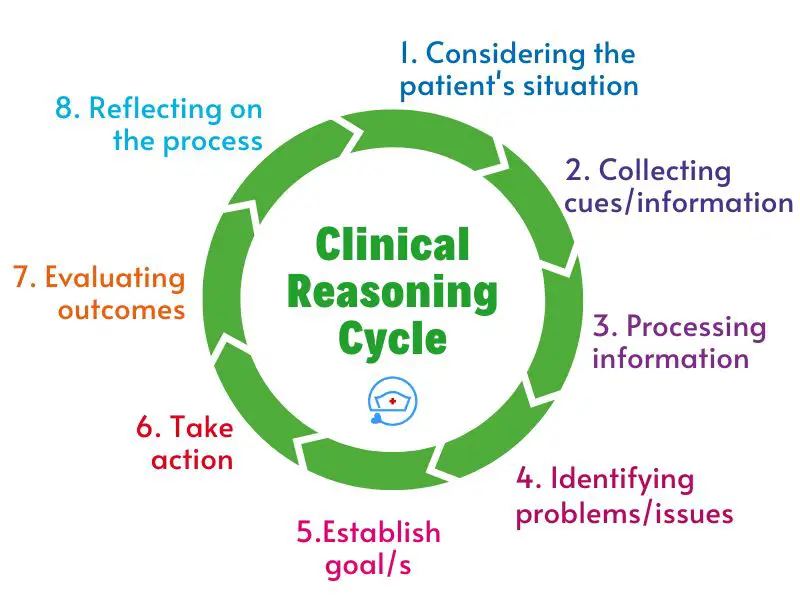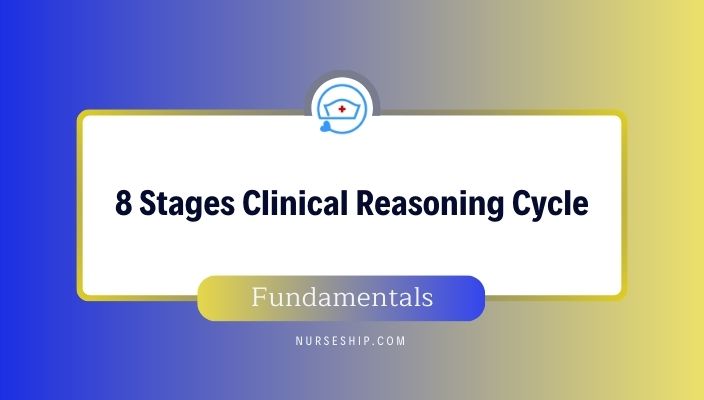Last updated on August 19th, 2023
In this article, we will be exploring the clinical reasoning process and its importance in healthcare.
The clinical reasoning cycle, developed by Tracy-Levett Jones, breaks down this process into eight phases that healthcare professionals can follow to make informed decisions for their patients.
These phases include considering facts, collecting information, processing gathered information, identifying the problem, establishing goals, taking action, evaluating the effectiveness of the action, and reflecting on the experience.
By following this cycle, healthcare professionals can enhance their problem-solving and decision-making skills, leading to better patient care.
Related: Clinical Reasoning In Nursing (Explained W/ Example)
8 Stages of the Clinical Reasoning Cycle

The eight stages of the Clinical Reasoning Cycle are the following.
- considering the patient’s situation,
- collecting cues/information,
- processing information,
- identifying problems/issues,
- establishing goals,
- taking action,
- evaluating outcomes, and
- reflecting on the process.
These eight phases guide healthcare professionals in providing optimal care to patients.
Each stage is interconnected and builds upon the previous one, allowing for a comprehensive understanding of the patient’s needs and effective decision-making.
1. Consider the patient’s situation
The first phase of the Clinical Reasoning Cycle involves considering the facts presented by the patient or situation. This is where healthcare professionals receive the initial information and medical status of the patient.
For example, they may be given details about a newborn admitted to the Neonatal Intensive Care Unit (NICU) due to neonatal jaundice.
By carefully considering these facts, healthcare professionals can start to develop an understanding of the patient’s condition and determine the appropriate course of action.
2. Collect cues/ information
In the second phase, healthcare professionals gather additional information to gain a comprehensive understanding of the patient’s medical history, complaints, treatment plan, and current vital signs.
They may also review the results of any investigations or tests conducted. This information is then analyzed using the healthcare professional’s knowledge of physiology, pharmacology, pathology, culture, and ethics to establish cues and draw conclusions.
The collection of information is a crucial step in the clinical reasoning process, as it helps healthcare professionals to identify any underlying issues or potential challenges.
3. Process information
The third phase involves the processing of the information gathered in the previous step.
It is here that healthcare professionals critically analyze the data on the patient’s current health status in relation to pathophysiological and pharmacological patterns.
They determine which details are relevant and consider potential outcomes for the decisions they may make.
This phase requires healthcare professionals to use their expertise and judgment to identify the key issues that need to be addressed.
4. Identify problems/issues
Based on the processed information, healthcare professionals can identify any problems or issues that the patient may be facing.
This involves recognizing signs and symptoms, understanding the underlying causes, and determining the potential impact on the patient’s health.
5. Establish goals
Once the problems or issues are identified, healthcare professionals can establish goals for the patient.
These goals are aimed at addressing or resolving the identified problems and improving the patient’s health outcomes.
Goals should be specific, measurable, achievable, relevant, and time-bound (SMART).
6. Take action
After establishing goals, healthcare professionals take appropriate actions to address the identified problems and work towards achieving the established goals.
This may involve implementing treatment plans, providing interventions, administering medications, or coordinating care with other healthcare professionals.
7. Evaluate outcomes
The seventh phase of the Clinical Reasoning Cycle is evaluation. In this phase, healthcare professionals assess the effectiveness of the actions they have taken.
They evaluate whether the treatment plan has been successful in achieving the desired outcomes or if adjustments need to be made.
This phase allows healthcare professionals to reflect on their decisions and make informed judgments about the next steps in the patient’s care.
8. Reflect on the process and new learning
The final phase of the clinical reasoning cycle is reflection. Healthcare professionals reflect on the entire process, including their decision-making, actions taken, and the outcomes achieved.
This reflection allows for continuous learning and improvement, as healthcare professionals gain insights from their experiences and apply them to future situations.
See Also:
- How To Improve Critical Thinking Skills In Nursing? 24 Strategies With Examples
- What Are Socratic Questions?
- What is the “5 Whys” Technique?
- 15 Attitudes of Critical Thinking in Nursing (Explained W/ Examples)
References
Levett-Jones, T. (Ed.). (2013). Clinical reasoning: Learning to think like a nurse. Pearson Australia.



Comments are closed.